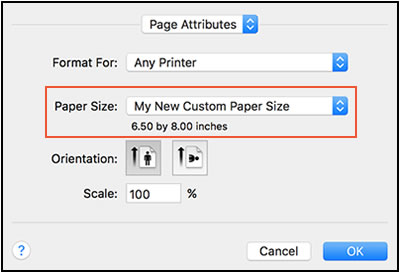
- #Word for mac custom page size how to#
- #Word for mac custom page size manual#
- #Word for mac custom page size plus#
If there are no gaps enter just the label height or width.
#Word for mac custom page size plus#
Vertical Pitch & Horizontal Pitch – these are label height plus row gap height and label width plus column gap width respectively.


With “Create Labels”, you enter the measurements of your sheet labels and the tool automatically creates a suitable label template.
#Word for mac custom page size how to#
How To Create A Label Template In Word Using Create Labels Template Tuesday Presents.how to create label templates in Word using Create Labels & Insert Table tools.
#Word for mac custom page size manual#
The latest Draw manual is for v.4.3 maybe this tool is newer? Anyway, how can it be turned off? I finally figured out that if I closed the document and reopened it, the tool reverted to off but I can’t believe this is the official method.Or copy the link! How To – How To Create Your Own Label Templates In Word I searched in the Draw manual for “Zoom & Pan”, found nothing searched “Zoom” and found a bunch of mentions, but nothing relevant. Clicking again on the tool icon didn’t do it, nor did double-clicking. However, while researching this, I ran into another problem: I inadvertently tapped on the icon for Zoom & Pan, which turned the cursor into a magnifying glass (over the document) – and then could find no way to turn it OFF. If the reference is to the F11 key in the top row of the keyboard (MacBook Pro, early 2013), pressing that either (a) raises audio volume, or (b) (with fn key) clears the Desktop by moving all windows to the edge of the screen. Puzzled: ajlittoz wrote: “…change specific page styles which you access with F11, fourth icon in the toolbar.” Is that the fourth icon from the left in the toolbar across the top of the window? In the toolbar I see (default, unmodified) there is nothing labeled “F11” (the fourth icon is Export), nor is there anything with that name in the list under View ->Toolbars ->Customize…. I’ve been in the Mac world exclusively for going on 30 years, but had heard that in Windows (and I’d guess in Linux, which generally follows Windows ways of doing things) procedures tend to be application-specific (and sometimes widely varying) where in Macintosh, where applications are more thoroughly integrated into the ecosystem, they are done globally in the OS. Which is fine for my purposes.Īnyway, as this is my first adventure with LO, what I found interesting was the difference in style. Why would such a simple thing be done differently in different platform versions of the application? Seems needlessly confusing.Īs Mike Kaganski notes, indeed, the page size setting is document-wide change it for any page and it changes the whole document. HerCorns said Format → Pages… ->Page is that the Windows or Linux version? As noted in the OP, I’m in MacOS (10.12, the 2016 version). As Ratslinger first noted, the solution is found in Format ->Page Properties… ->Page.


 0 kommentar(er)
0 kommentar(er)
